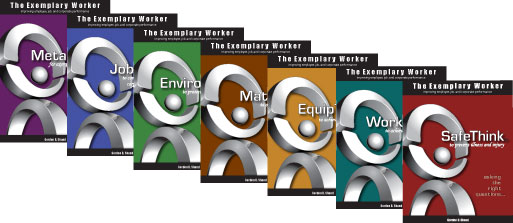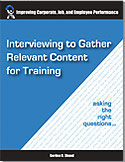The Exemplary Worker book series
Powerful Strategies for improving Employee, Job, and Corporate Performance.
Improve your job satisfaction, retention, and promotion.
About the Author, Gordon Shand Available in stores January 2015
The Strategy
Books in The Exemplary Worker series focus on the critical thinking strategies exemplary workers use to maintain outstanding performance and contribute to personal, job, and business success.

Benefits
Using thinking strategies for the workplace can contribute to improved job satisfaction, retention, and promotion. You will learn new thinking strategies to work more safely, effectively, and efficiently and with less effort. The thinking strategies will also help you be more effective at solving problems and be more flexible in adapting to changes. You will also be able to quickly learn new jobs. These thinking strategies will help you to perform better in any job and work environment. And, using the thinking strategies, you will be a more effective mentor.
Who can Benefit
- individuals who want to be outstanding employees
- apprentices and students who want to work safely and effectively
- supervisors who want staff to be more effective
- trainers who want to contribute to improved corporate, job, and employee performance
- trades instructors who want their apprentices to work safely and effectively
- instructional designers who want to ensure that training is relevant, useful, and practical
- HR managers who want to improve the development and retention of exemplary workers
- operations staff who want to optimize production and minimize losses
Testimonials
Here's what others say about the book series:
"Rarely can workers from any sector access self-paced instructional materials that are easy-to-use, step-by-step guides to workplace learning. The Exemplary Worker book set is an exception. These books offer a good breadth of learning for workers in contexts ranging from: exemplary performance; job and corporate performance; results optimization; and work excellence. With meticulous organization, these essential training references are helpful guides for workers seeking to improve their performance. With prefaces designed to help trainers/instructors assist workplace learners, these books use critical thinking strategies that identify what matters to workers and supervisors considering people, equipment, materials, environments, and organization in concert."
Eugene G. Kowch, Ph.D., Leading Complex and Adaptive Learning Systems/Organizations, University of Calgary, Canada.
“The power of thinking in determining our safety, health, and welfare is obvious, but how to manage such cognition or self-talk for injury prevention, self-motivation, and self-improvement is not so obvious. Answers are provided in this action-focused series of self-help books on The Exemplary Worker by Gordon D. Shand. He offers much practical information for leadership, safety, and well-being. Each of these books provides critical and structured thinking strategies for optimizing performance on several fronts, from improving safety and productivity in the workplace to actively caring as a teacher, parent, or friend.”
E. Scott Geller, Ph.D., author of The Psychology of Safety Handbook; Alumni Distinguished Professor, Virginia Tech; Senior Partner, Safety Performance Solutions.
“These are very practical books. I, myself, have been interested in the fundamental processes of human thinking. For creativity there is Lateral Thinking. For exploration there is the parallel thinking of the Six Thinking Hats. For perception there is the CoRT school programme. The Exemplary Worker series of books provide frameworks for focused thinking about specific situations. The frameworks guide the thinker to deal with the situation instead of messing about. That is why the books are so practical.”
Edward de Bono, author of Lateral Thinking and Six Thinking Hats and creator of CoRT.
The Focus
The Exemplary Worker book series is based on the LO-PEMEO™ model (Loss and Optimization of People, Equipment, Materials, Environment, and Organization) to identify what is important for improved employee, job and business performance.
The first five books focus on the thinking strategies that help employees think through their work so they can do their jobs safely, efficiently, and effectively. The sixth book JobThink focuses on thinking strategies exemplary workers use to perform effectively within their organizations and contribute to job and corporate performance. The seventh book MetaThink applies the thinking strategies learned in the first six books in different ways and also introduces new thinking strategies useful for exemplary performance.
|

326 Pages |
SafeThink . . . to prevent illness and injury
SafeThink is a structured critical thinking strategy you can use to identify and predict hazardous situations before, during, and after completing work. This cognitive-based safety strategy can be used on the fly, at work, at home, at play, and while driving. SafeThink also provides strategies for you to remain focused on your tasks.
more... |
|

110 Pages |
WorkThink . . . to achieve excellent results
WorkThink is a thinking strategy you can use to achieve quality results with the least amount of effort. It usually takes little extra effort to do quality work instead of inferior work. WorkThink also emphasizes understanding the expectations of your supervisor, team leader, and customers so that you can achieve the excellent results they expect.
more... |
|

144 Pages |
EquipThink . . . to achieve optimal results
EquipThink is a thinking strategy for you to use tools, mobile equipment, and stationary equipment effectively and efficiently. The goals are for you to achieve the desired results with minimal stress on equipment, to conserve energy, and to extend equipment life. The input-process-output thinking strategy, in conjunction with identifying critical variables, is used to achieve optimal results.
more... |
|

100 Pages |
MatThink . . . to optimize materials
MatThink is a thinking strategy you can use to make the most effective use of materials. The thinking strategy applies to recovering, processing, modifying, applying, transporting, and storing materials. Because equipment and materials are usually closely related, the input-process-output thinking strategy, in conjunction with identifying critical variables, is used to optimize material recovery and use.
more... |
|

146 Pages |
EnviroThink . . . to protect the environment
Both industry and individuals have a responsibility to protect the environment. EnviroThink is a critical thinking strategy you can use to identify and respond to environmental issues for any job position that you might hold. EnviroThink helps you think through your work by asking yourself specific questions relating to environmental issues important to organizations.
more... |
|

150 Pages |
JobThink . . . to contribute to job and corporate performance
Exemplary workers understand what is important to their organizations. They know the issues critical to business success and where to focus their efforts. JobThink addresses the critical thinking strategies you can use to identify what is important for job and corporate performance.
more... |
|

130 Pages |
MetaThink . . . for exemplary performance
The term meta means encompassing and more developed. MetaThink helps you develop new thinking strategies and integrate the thinking strategies you learned in the first six books. When you use a broad set of thinking strategies, you are more effective in assessing issues, determining what is important, and focusing your efforts. The goal is for you to work effectively and in ways that contribute to job and organizational performance.
more... |
Do you want to learn about the thinking strategies used by exemplary workers?
Click below to order the books.

|
Interviewing to Gather Relevant Content for TrainingAvailable in stores May 2015
Powerful Strategies for interviewing Subject Matter Experts (SMEs) to gather training content that contributes to business success.
Improve employee, job, and corporate performance
|
There are many challenges when interviewing Subject Matter Experts (SMEs) to gather relevant content for training. Experienced workers often have difficulties in identifying content for training; they cannot separate the chaff from the wheat. This book provides strategies you need to provide the leadership to direct the SME to identify relevant training content—content that contributes to improved worker, job, and corporate (organization /business) performance. The relevant training you then develop will give your organization the best return on its investment in training. And, trainees will be more receptive to the training because the training focuses on issues important to their work.
Part 1 of this book describes thinking strategies and relevant content criteria you can use during the interview to direct the SME. Pitfalls and solutions are also provided.
Part 2 explains a content interviewing process you can adapt to get the most out of the interviewing process.
Who can Benefit
- educational, training, and performance consultants
- training program designers
- instructional designers
- technical writers
- trainers and coaches
- internal staff who develop training
Testimonials
"Good instructional designers have always been good listeners and good communicators, but it is often difficult to tell people precisely how to do this. In Interviewing to Gather Relevant Content for Training the interview process is carefully analyzed and systematically explained, reflecting a wealth of practical experience. While a content identification interview is complicated, detailed, and time-consuming, Gordon Shand (in the best instructional design tradition) has made it seem simple and entirely within reach."
Rita C. Richey, Ph.D., coauthor of The Instructional Design, Knowledge Base: Theory, Research, and Practice; Professor Emeritus, Instructional Technology, Wayne State University.
“Interviewing to Gather Relevant Content for Training is a must have reference book for any learning and development professional tasked with identifying content for training. Gordon Shand’s book dives deep into the concepts of relevant content and interviewing to give a robust and complete picture of this required skill. This book is filled with practical advice and models that are immediately applicable. The most important aspect of the book is that Shand keeps you focused on the business – something that sets this book apart from the rest!”
Jenn Labin, author of Real World Training Design and Managing Principal of T.E.R.P. Associates.
“Clearly Gordon Shand has a large amount of experience creating training. The book, Interviewing to Gather Relevant Content for Training, which is relevant for both technical and non-technical training, includes examples that relate to a wide range of industries and organizations. The specific questions he offers for performing a needs analysis and gathering content are a valuable addition to any training practitioner’s toolkit.”
Sarah Wakefield, author of Technical Training Basics Click below to order the books.
|




